Extremadura is a great place for wildlife, one of the best birding sites in Spain and even in Europe. The middle of June is not the best time to visit, particularly in the middle of a heatwave, but with a few days off I decided to head down there for a few days.
We have just announced that The Bird ID Company will be offering international tours starting in 2018, in partnership with our friends at Oriole Birding (for more details, see the website here). The first destination will be Extremadura in January next year, which I will be co-leading. I haven’t been to Spain for a couple of years and wanted to explore a few sites ahead of the forthcoming tour, so this was an ideal opportunity, even if the summer months are not the best time to visit – Winter and Spring are far better.
Despite it being the wrong time of year and unseasonably hot (touching 43C at times!), I managed to catch up with most of the main species and much more besides. Here are just a few highlights…
Steppe birds are one of the main reasons to visit Extremadura – bustards and sandgrouse. Great Bustards were seen most days when I was out on the plains, in small groups, the biggest being thirteen together which I found on several days in the same fields. There are also Little Bustards here, but they are very hard to see at this time of year, when the grass is very tall – they are easier in winter or spring.
 Great Bustard – seen regularly out on the plains
Great Bustard – seen regularly out on the plains
Sandgrouse can be hard birds to find sometimes, but this is a great place to look for them. Early morning is best, and their distinctive calls give their presence away as they fly in to feed. I was fortunate to enjoy great views of both Pin-tailed Sandgrouse and Black-bellied Sandgrouse, both in flight and feeding in the stony fields.
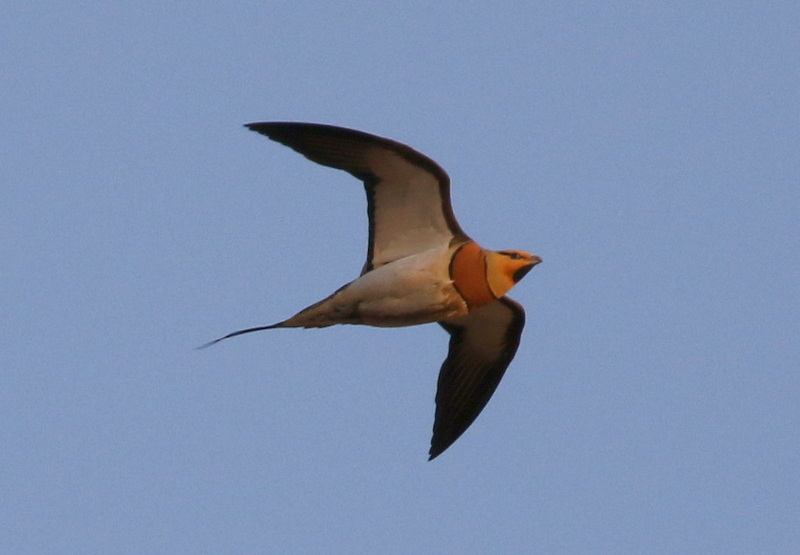 Pin-tailed Sandgrouse – stunning birds when seen through the scope
Pin-tailed Sandgrouse – stunning birds when seen through the scope
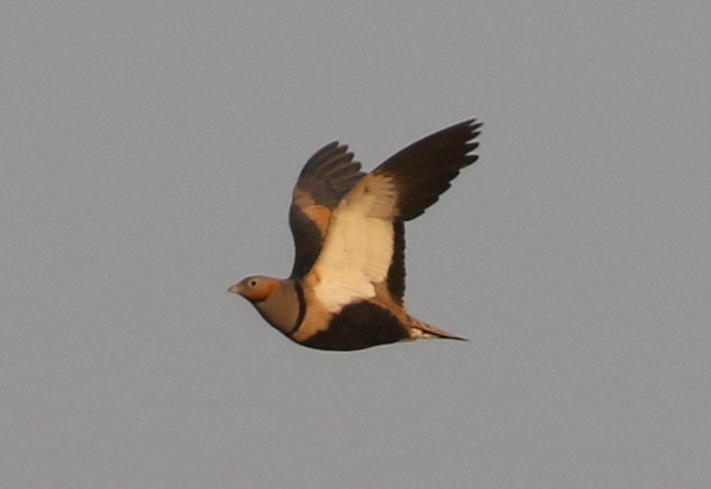 Black-bellied Sandgrouse – I saw fewer of these than Pin-tailed, but still several pairs
Black-bellied Sandgrouse – I saw fewer of these than Pin-tailed, but still several pairs
The other big draw of Extremadura is the raptors. The Spanish Imperial Eagle is chief amongst them, a very rare and localised species. The total population was down to as few as 30 pairs in the 1960s, but has since recovered to an estimated 485 pairs in 2015. There is normally a reliable site for them in Monfrague National Park, but with the much watched pair’s breeding attempt there seemingly having failed this year, I realised it was going probably going to be necessary to see one elsewhere. I was fortunate to see one out on the plains, a cracking adult perched on a pylon.
 Spanish Imperial Eagle – great views of this very localised species
Spanish Imperial Eagle – great views of this very localised species
Apart from eagles, vultures are also much in evidence. Black Vulture is quite a sparsely distributed bird elsewhere in Europe, but is quite easy to see here. It is possible to get some quite spectacular views of vultures, with a bit of luck. There is nothing quite like watching them sail past at eye level!
 Black Vulture – soaring past in the sierras….
Black Vulture – soaring past in the sierras….
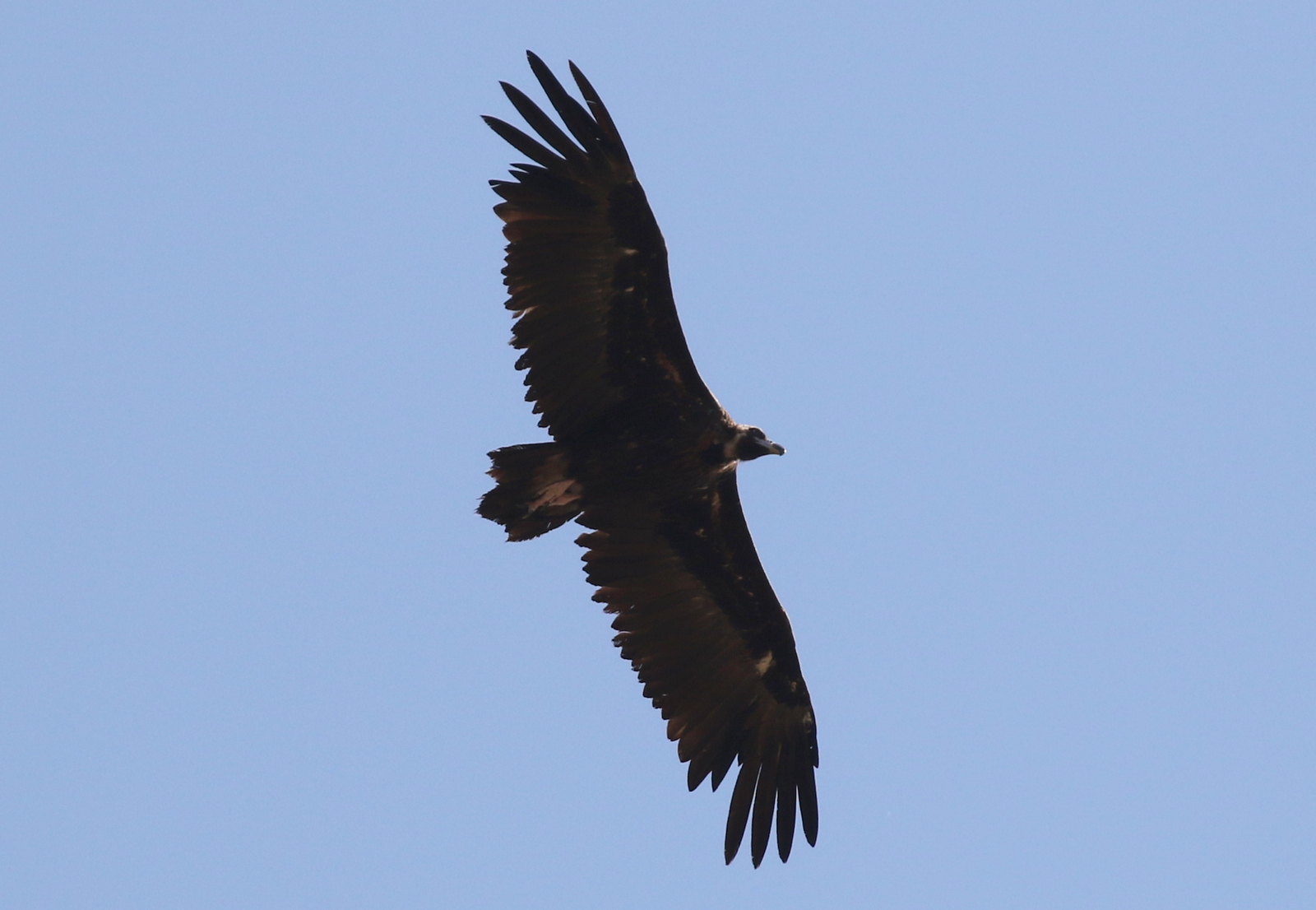 Black Vulture – … or circling over the plains
Black Vulture – … or circling over the plains
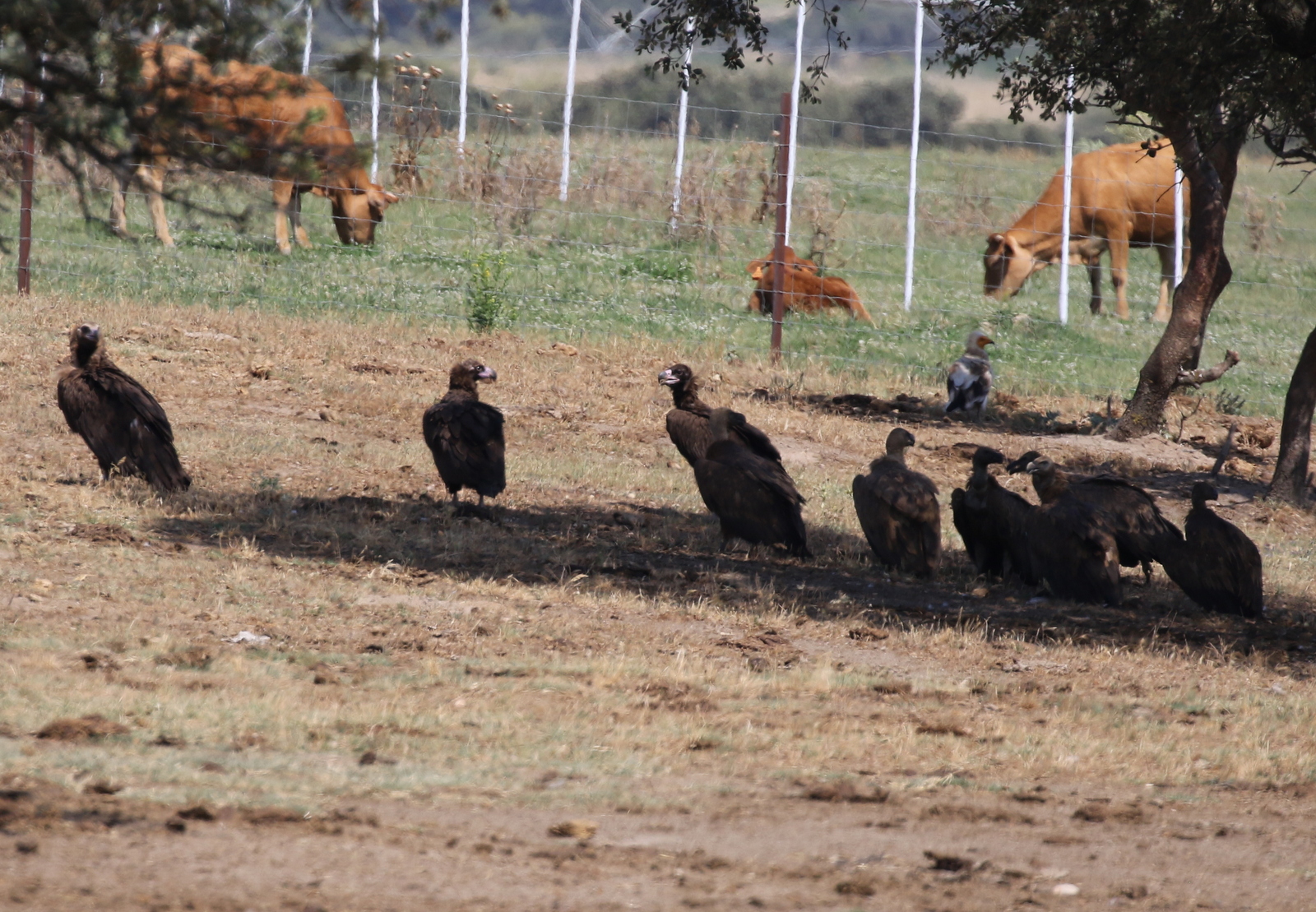 Vultures – three species together – seeking shade in the trees on a very hot day
Vultures – three species together – seeking shade in the trees on a very hot day
Griffon Vultures are more common, but the views in Extremadura are still spectacular. Monfrague National Park is a great place to watch them up close.
 Griffon Vulture – always great to see them up close
Griffon Vulture – always great to see them up close
Egyptian Vulture is probably the scarcest of the three vulture species here. Still, they are not hard to see in Monfrague National Park and I ran into several elsewhere too, including this young bird which came in to investigate me out on the plains early one morning, circling low overhead!
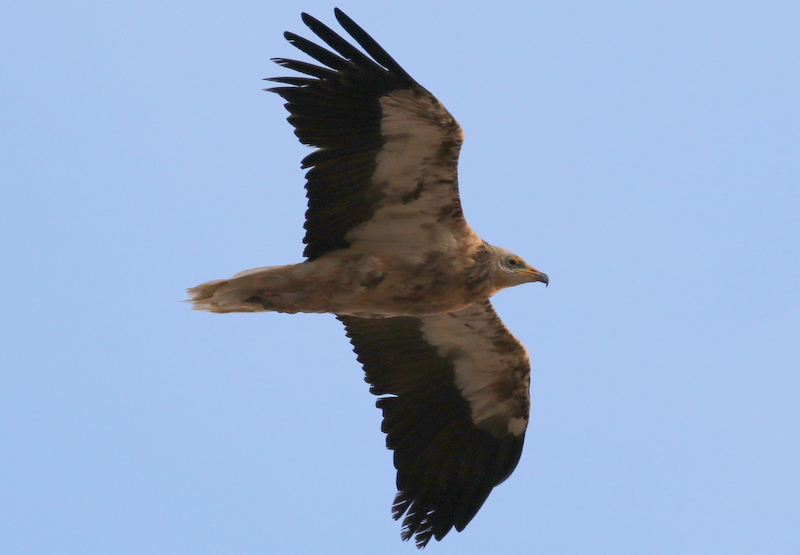 Egyptian Vulture – flew low overhead one morning out on the plains
Egyptian Vulture – flew low overhead one morning out on the plains
Other than the vultures and eagles, there are kites too. Black-winged Kite is more common in Africa and Asia, but is found in small numbers in Iberia. It only colonised Europe in the 1970s, and the population here is still perhaps only around 2,000 pairs. It is best looked for at dawn or dusk, when it can be found hovering out over the fields, hunting. There are several good sites for the species in Extremadura. I really enjoyed catching up with a pair of Black-winged Kites out hunting on my last evening there – it was a great way to end the trip.
In contrast, Black Kite is one of the commonest raptors. They are summer visitors here, wintering in Africa, but can be seen everywhere at this time of year.
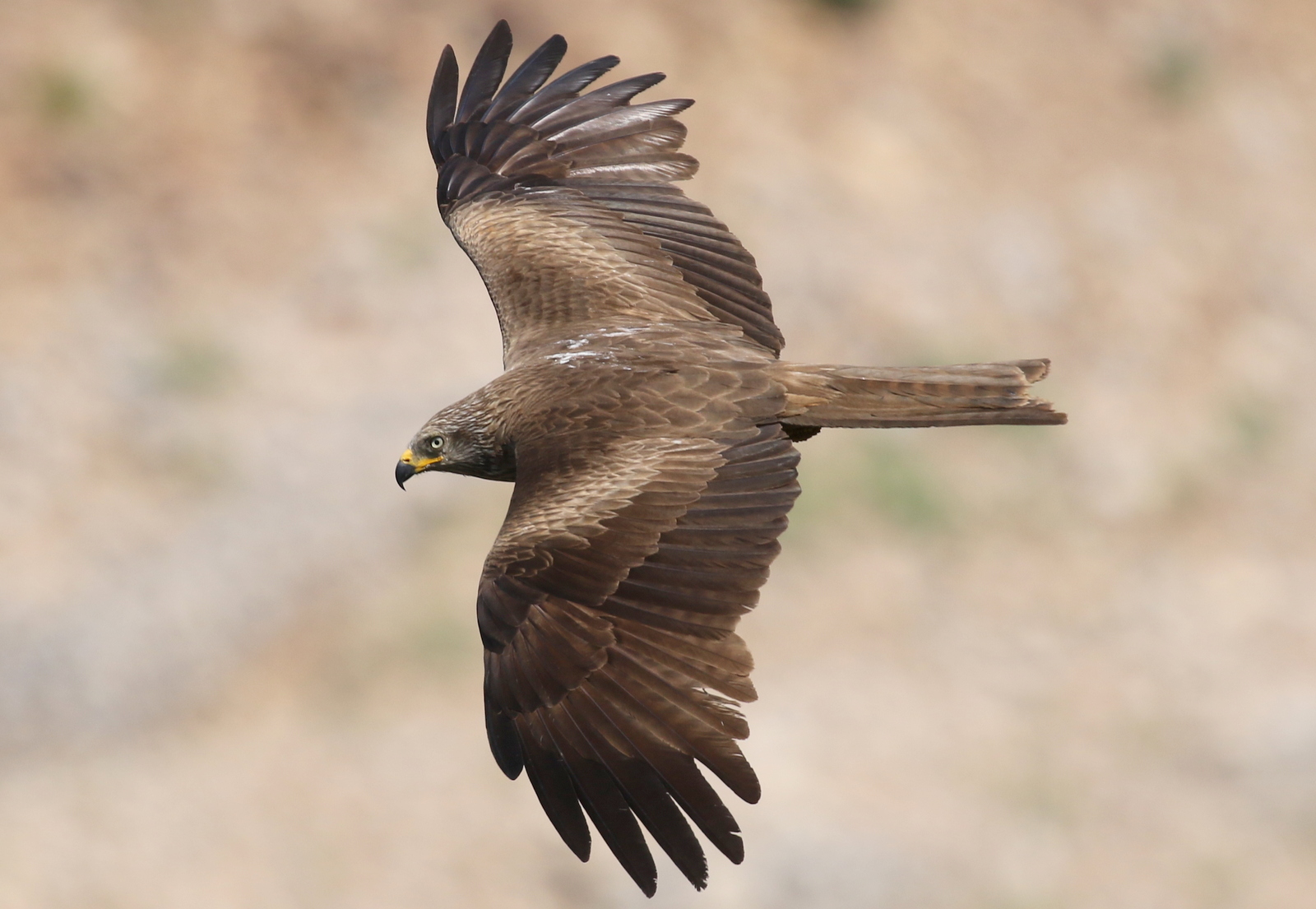 Black Kite – a very common summer visitor
Black Kite – a very common summer visitor
Lesser Kestrel is also one of the must see raptors at this time of year, again mainly a summer visitor, and is not uncommon, although there are plenty of Common Kestrels too. Trujillo is a good place to see them and the bullring there affords excellent views of – they breed in the roof and can be watched coming and going, bringing grasshoppers and crickets for their young, which were just fledging while I was there.
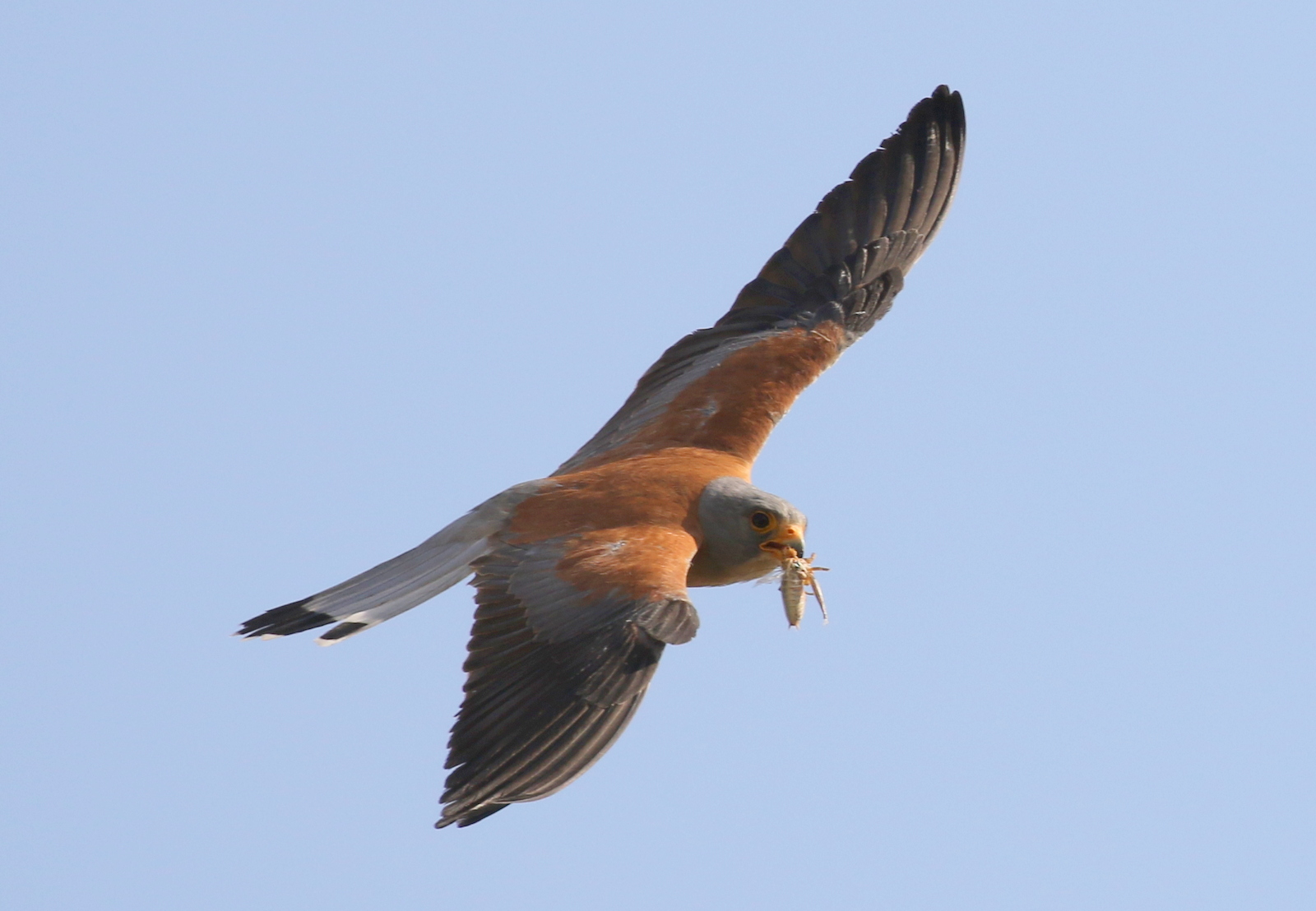
 Lesser Kestrel – fantastic views at Trujillo
Lesser Kestrel – fantastic views at Trujillo
Montagu’s Harrier is another summer visitor here, which breeds out on the plains. Some of the young seemed to have fledged by the time I arrived, and they were not as obvious as they can be earlier in the spring. Still, I saw several out on the plains, a mixture of adults and a few orange juveniles.
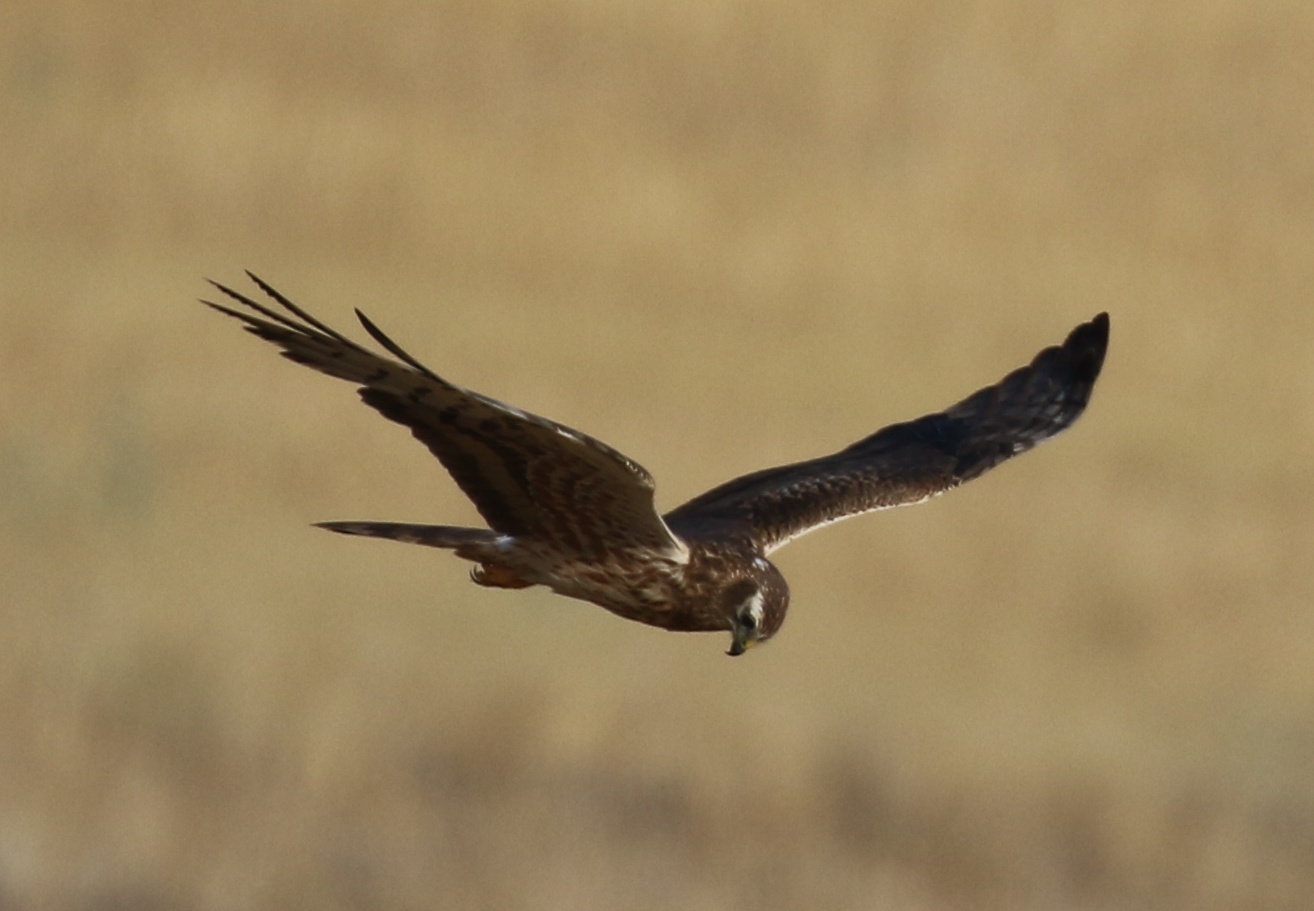 Montagu’s Harrier – hunting out over the plains
Montagu’s Harrier – hunting out over the plains
White-rumped Swift is another much sought after species here. It is much commoner in Africa and was only discovered in the late 1960s breeding just over the Straits of Gibraltar on the Spanish side, in Cadiz province. It has since spread north, but is still very localised on the Iberian peninsula. Monfrague National Park is a great place to see it, and I saw several there on my visit. Again, it is just a summer visitor here.
I have seen White-rumped Swifts in southern Spain before, but this is the first time I have been to Extremadura at the right time of the year. The views were superb! One of the highlights of my few days there.
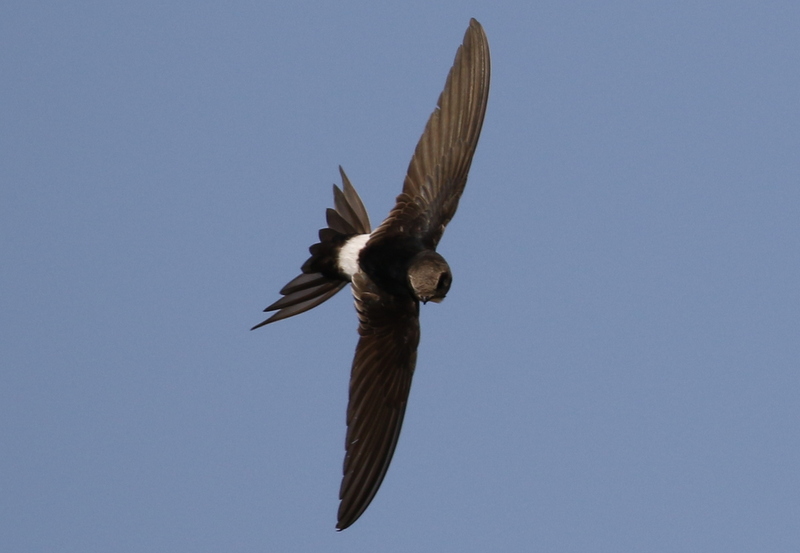
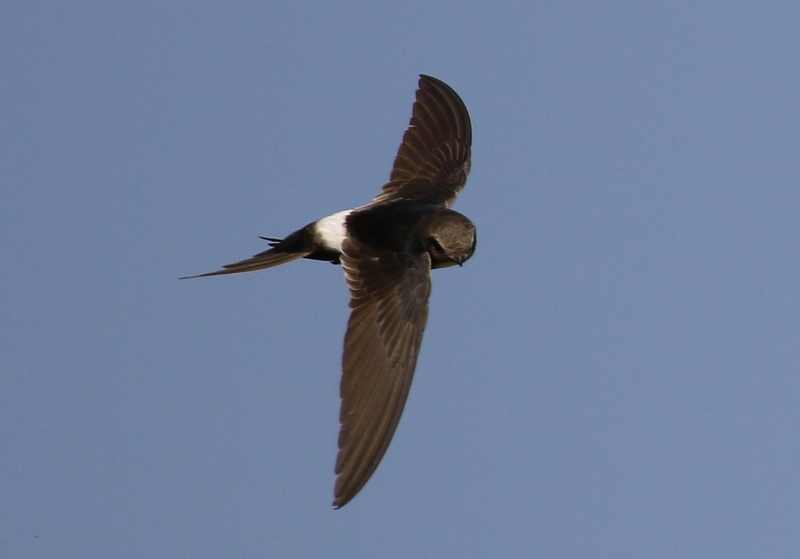

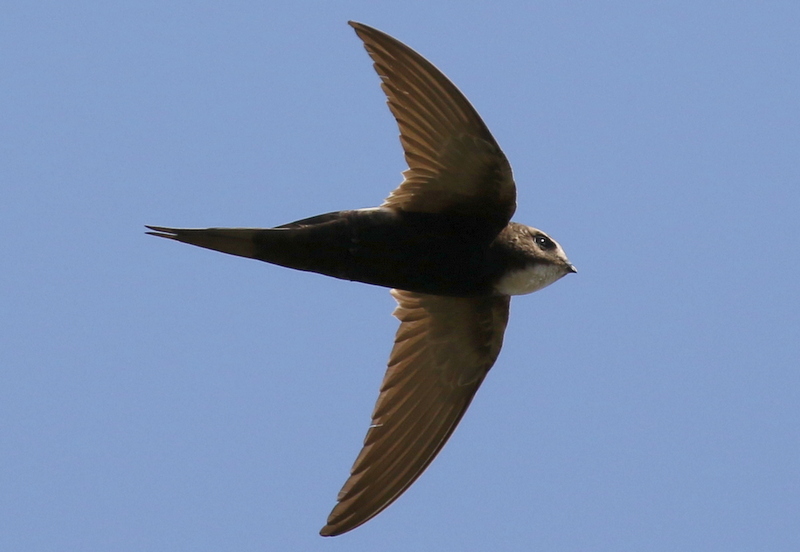
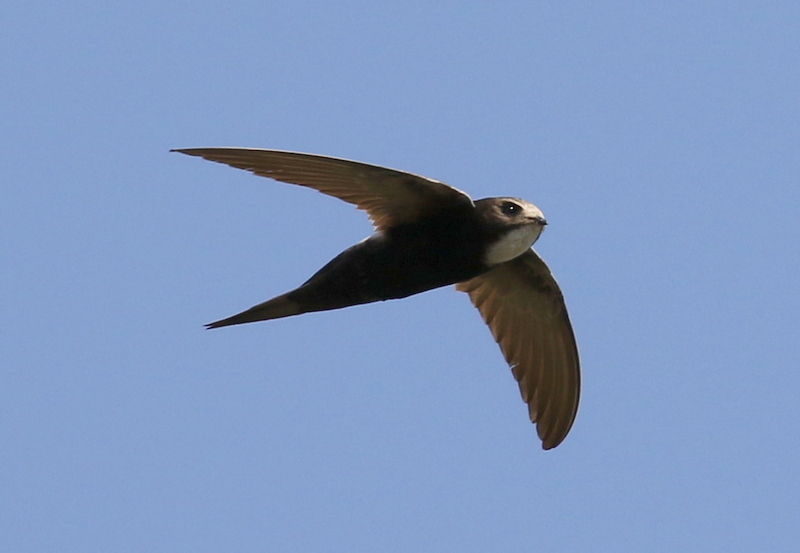
 White-rumped Swift – stunning views in Monfrague
White-rumped Swift – stunning views in Monfrague
Black Stork is another sought after species it is possible to see here in the summer. Again, Monfrague is a good place to see them, although I also saw several birds elsewhere on my travels. I saw several pairs nesting in Monfrague, with some half grown juveniles still in the nest.
 Black Stork – easy to see in summer in Monfrague
Black Stork – easy to see in summer in Monfrague
In contrast, White Storks are everywhere – it is hard to go far without seeing at least one! In the summer they can be found nesting on the roofs of buildings, electricity pylons and anywhere else they might consider remotely suitable – even if we might not! One pair even nests on top of one of the hides at Arrocampo.
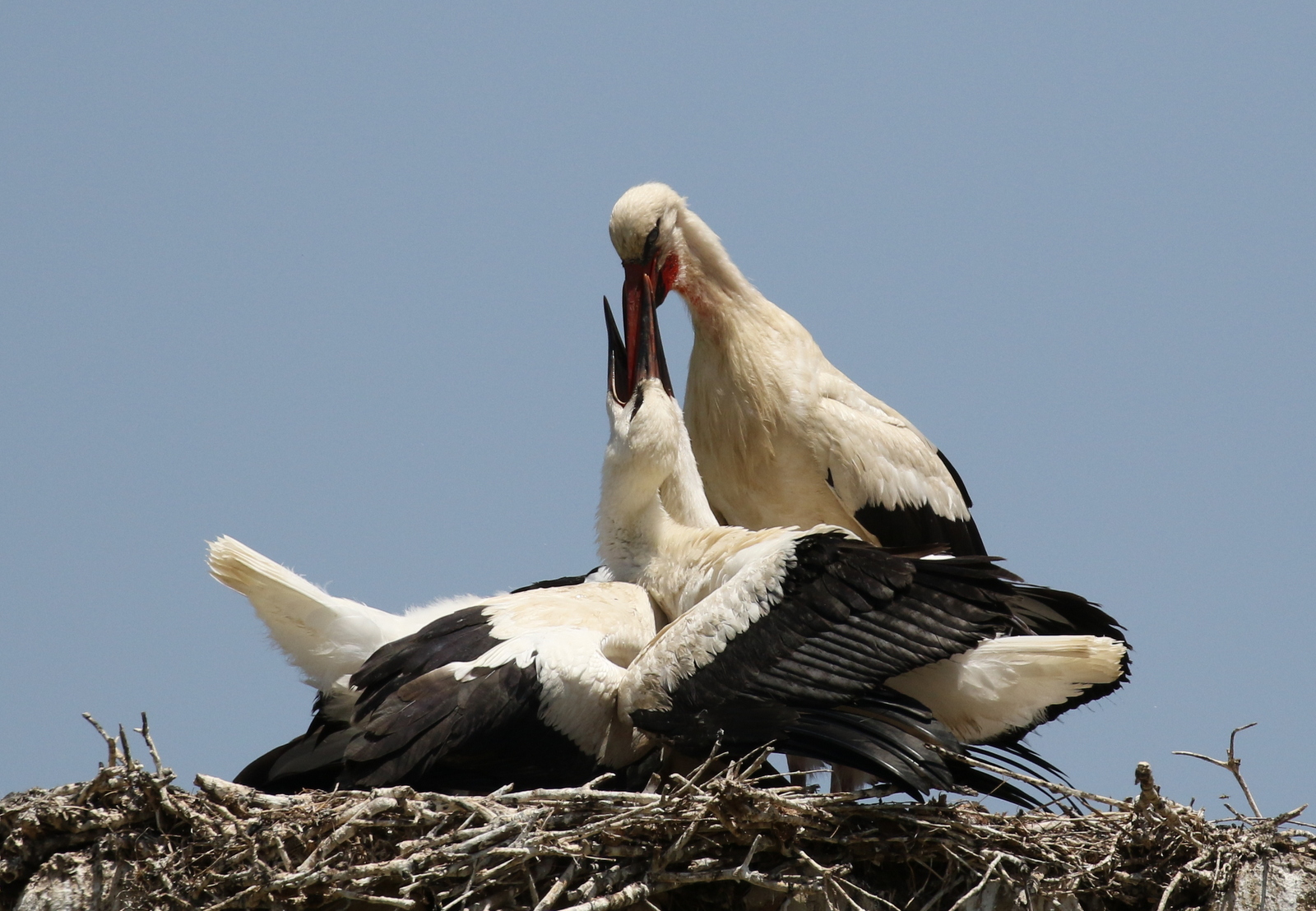 White Stork – feeding time back at the nest
White Stork – feeding time back at the nest
Azure-winged Magpie is another species which is limited to Iberia within Europe so is a species people want to see here. Remarkably, apart from Iberia it is also found in eastern Asia, and the two have traditionally been treated as conspecific but recent genetic analysis has suggested that the Iberian birds may be better treated as a separate species in their own right. Another good reason to see them.
Thankfully Azure-winged Magpie is common in Extremadura and easy to see. I spent a couple of very enjoyable mornings watching them in the garden of the hotel, coming down to crumbs put out for them or to drink. Nice to watch while relaxing by the pool!
 Azure-winged Magpie – Iberian birds are probably a unique species
Azure-winged Magpie – Iberian birds are probably a unique species
Where there are Magpies…. Great Spotted Cuckoo is a corvid brood parasite, particularly magpies, although Common Magpies are preferred hosts rather than Azure-winged Magpies. It is a summer visitor here, being found mainly in Iberian and south-eastern Europe. I saw a few out on the plains during my visit, getting some fantastic close views of one or two of them.
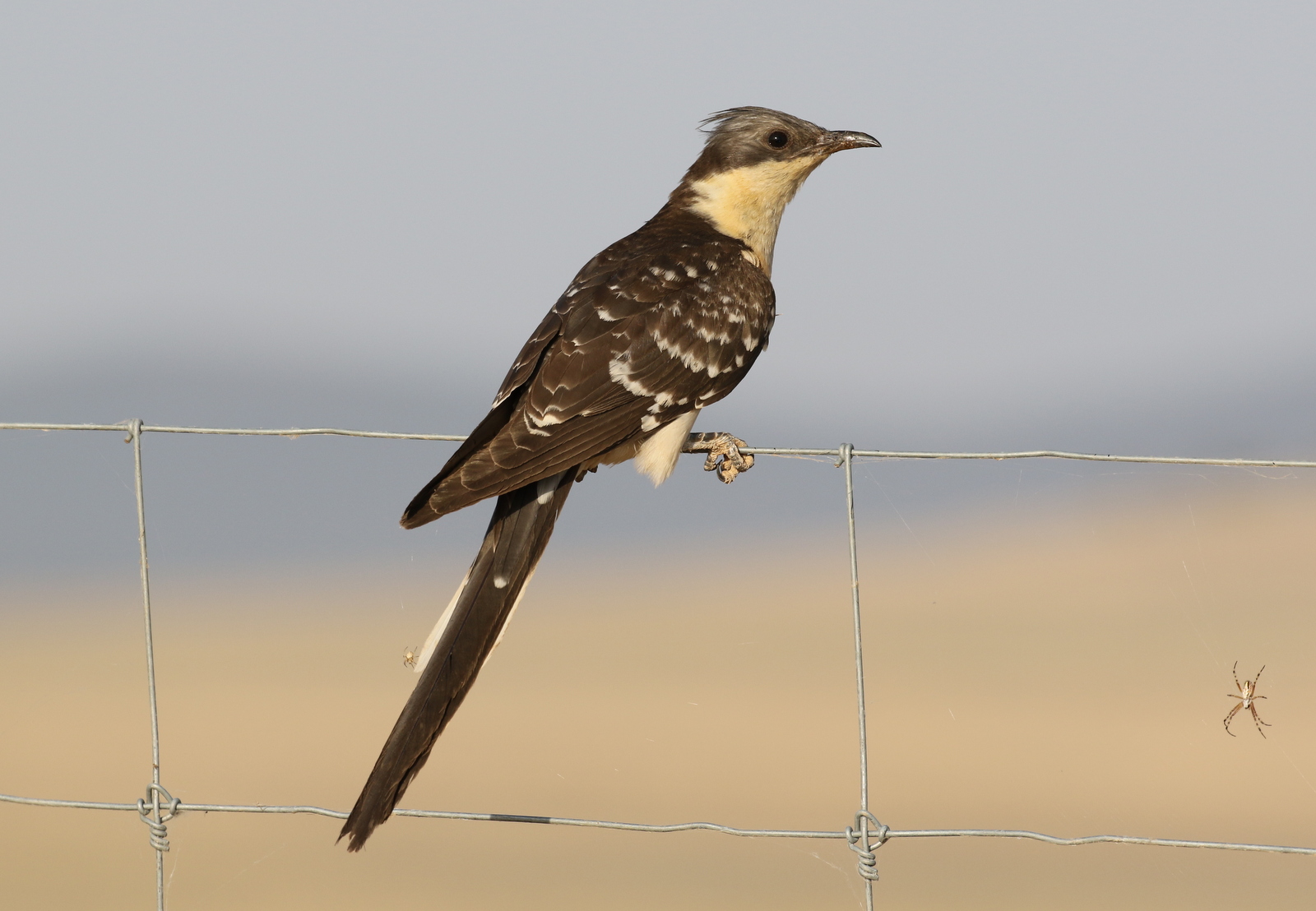 Great Spotted Cuckoo – an adult, out on the plains
Great Spotted Cuckoo – an adult, out on the plains
Roller is another species I wanted to catch up with, another summer visitor here. In some areas, nest boxes are put up on the telegraph posts for them and I was pleased to see quite good numbers where this was the case. They are great birds – along with Bee-eater and Hoopoe, a species I used to dream of seeing as a boy, thumbing through my father’s field guide. Even now, I love to watch Rollers and I was pleased to see some ‘rolling’ display flight too.
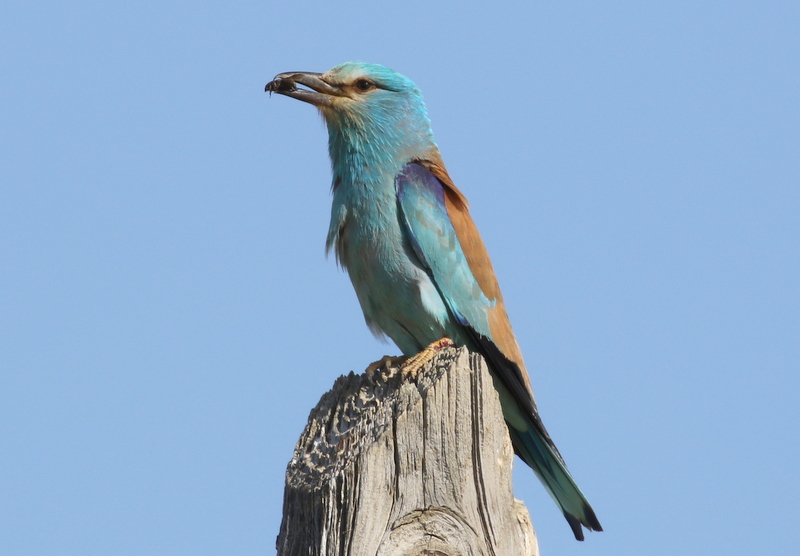 Roller – great to see so many here, benefiting from the provision of nestboxes
Roller – great to see so many here, benefiting from the provision of nestboxes
I saw plenty of Bee-eaters and Hoopoes as well – to this day, I still love seeing these too!
 Bee-eater – a common summer visitor here
Bee-eater – a common summer visitor here
Iberian Grey Shrike differs in appearance from the other Great Grey Shrikes found across Europe, being similar morphologically to some North African forms. Genetic studies have suggested it may not be particularly closely related to either, which is why it is often treated as a separate species. It is quite easy to see out on the plains, perched on the fences or wires.
 Iberian Grey Shrike – often treated as a distinct species, separate from ‘Great Grey’
Iberian Grey Shrike – often treated as a distinct species, separate from ‘Great Grey’
Iberian Grey Shrike is a resident, so can be seen throughout the year. I also saw lots of Woodchat Shrikes, which are summer visitors here. They were very common in the dehesa or on the edges of the plains, with many family parties and large numbers of juveniles already. Despite them being common, they were not particularly obliging and usually flew off before I could get close to them.
Rock Bunting is another resident species. During the summer, it is to be found in the sierras, although it is an altitudinal migrant, moving lower in the winter. I only saw one on my visit, on a trip up into the hills which also produced a singing Ortolan Bunting. I suspect I may have seen more, if it hadn’t been June and quite so hot! They are very pretty birds, well worth the effort of going into the sierras to see.
 Rock Bunting – a resident but localised species, in the sierras in summer
Rock Bunting – a resident but localised species, in the sierras in summer
The plains are full of larks and Corn Buntings – a real reminder of how impoverished our agricultural landscape is by comparison. Crested Lark is particularly abundant.
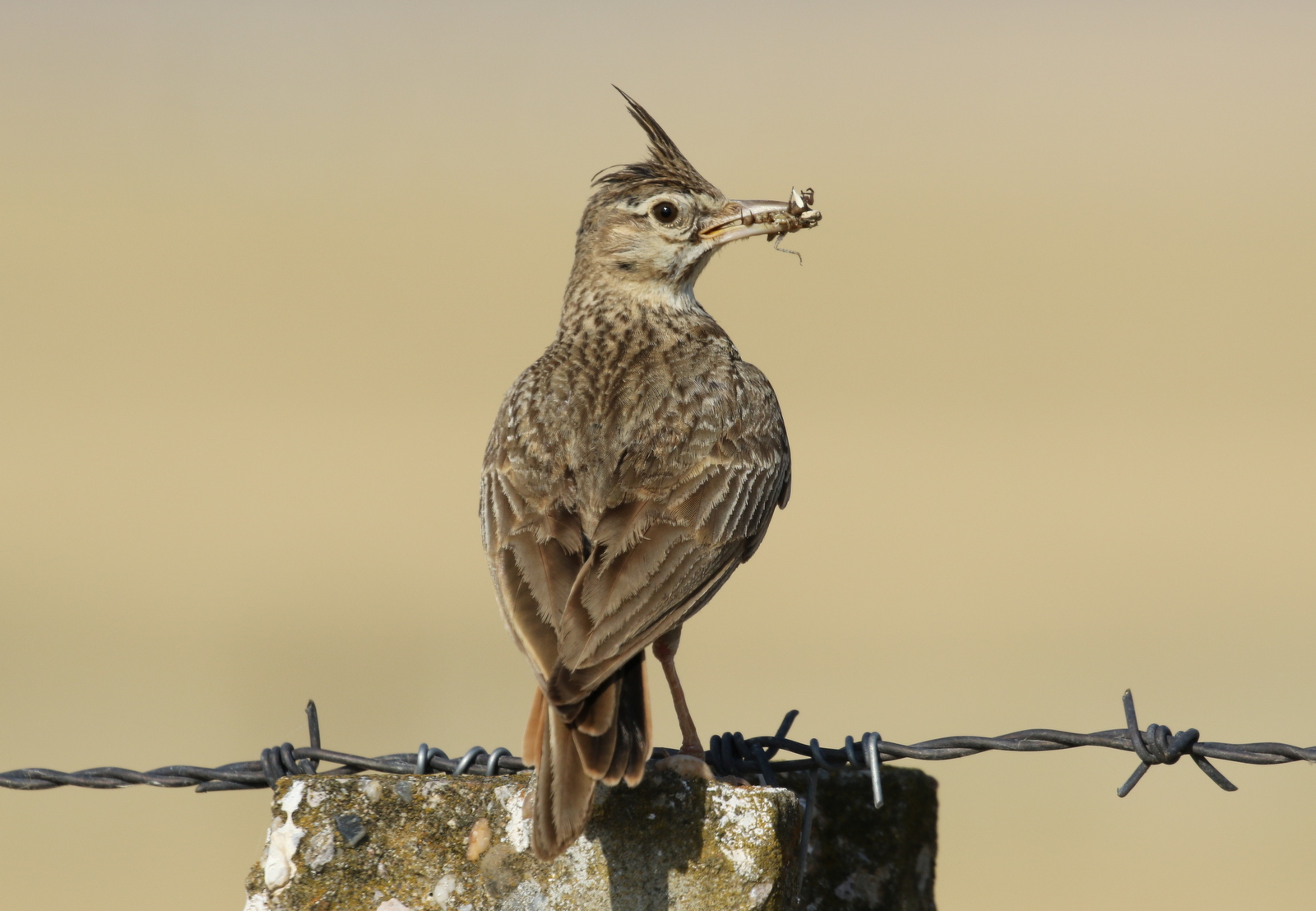 Crested Lark – abundant out on the plains and around the fields
Crested Lark – abundant out on the plains and around the fields
It was nice to see Calandra Larks in good numbers too, even if they didn’t pose quite so nicely for photos. I also saw a few Short-toed Larks as well.
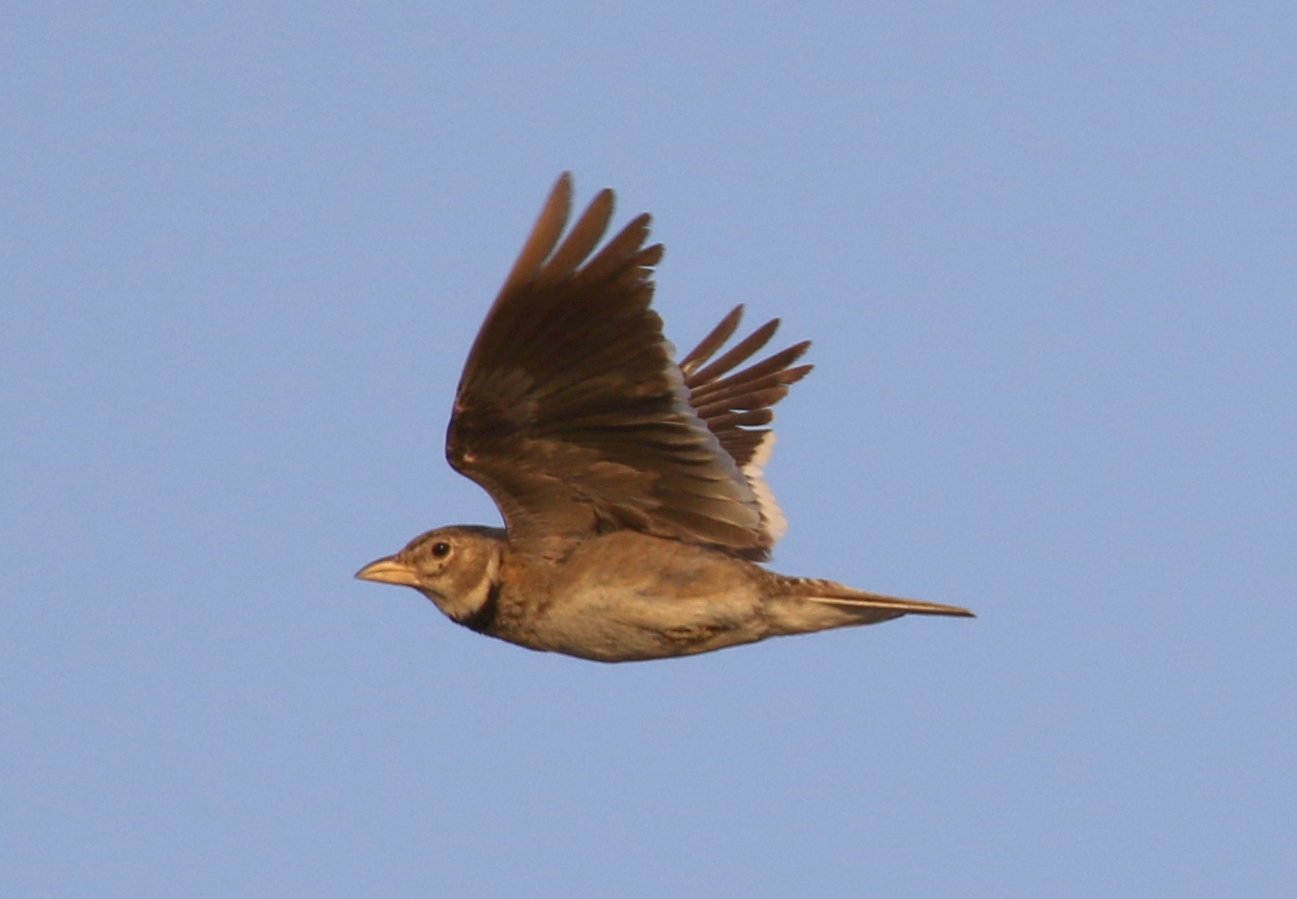 Calandra Lark – nice to see in good numbers still here
Calandra Lark – nice to see in good numbers still here
In rockier areas, the Crested Larks are replaced by Thekla Larks. I did see a few of the latter, but they were not so obliging as the former, particularly as I found myself in the right areas mostly in the middle of the day.
There were loads of sparrows out on the plains too, many big flocks, mostly young birds. Both House Sparrow and Spanish Sparrow can be found here, and occasionally I came across a smart male Spanish Sparrow.
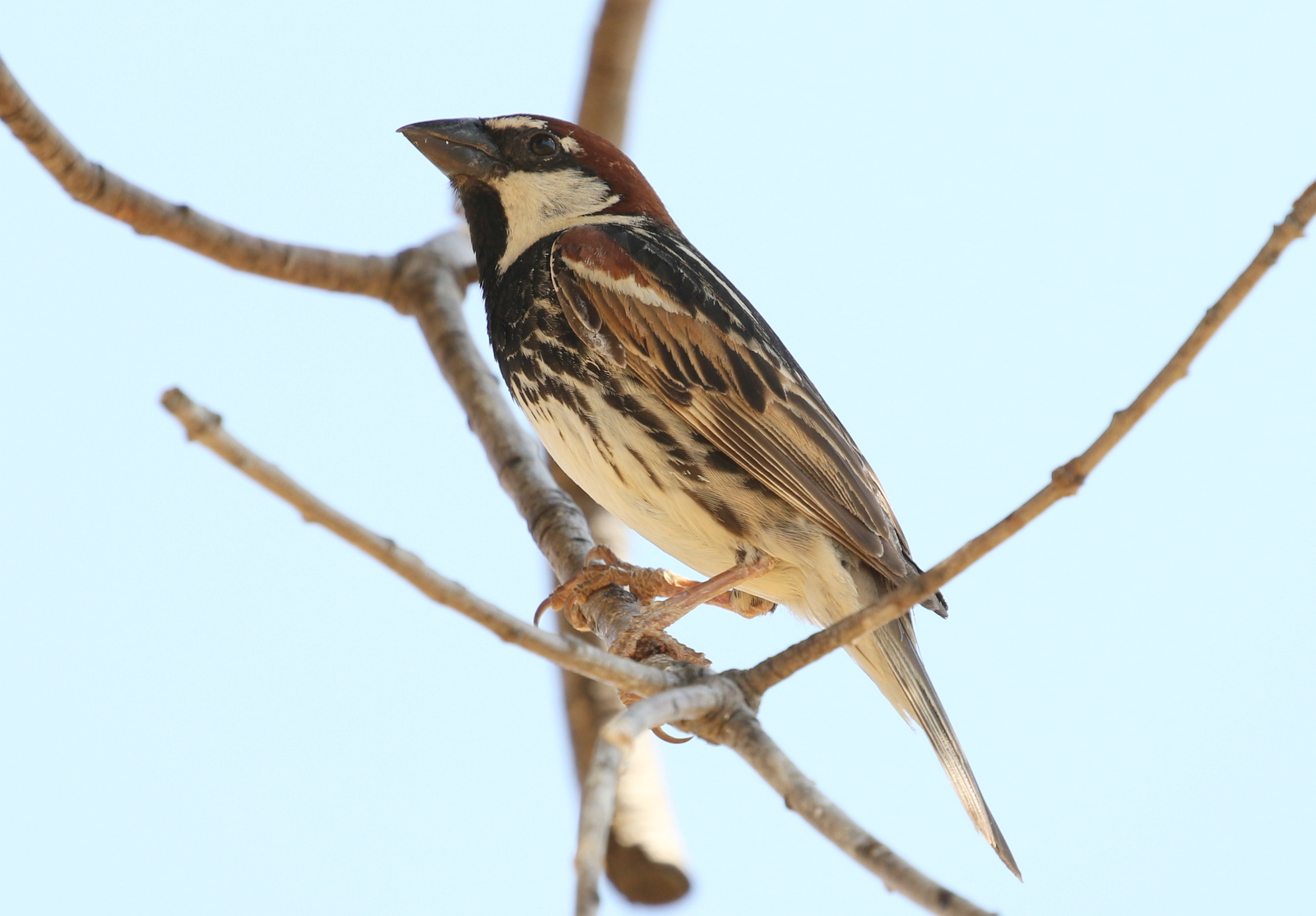 Spanish Sparrow – a male
Spanish Sparrow – a male
There are not as many warblers here as elsewhere in southern Europe, with even the normally ubiquitous Sardinian Warbler more sparsely distributed than around the Mediterranean. I was most pleased to find a family party of Western Orphean Warblers up in Monfrague as this can be a very tricky species to see.
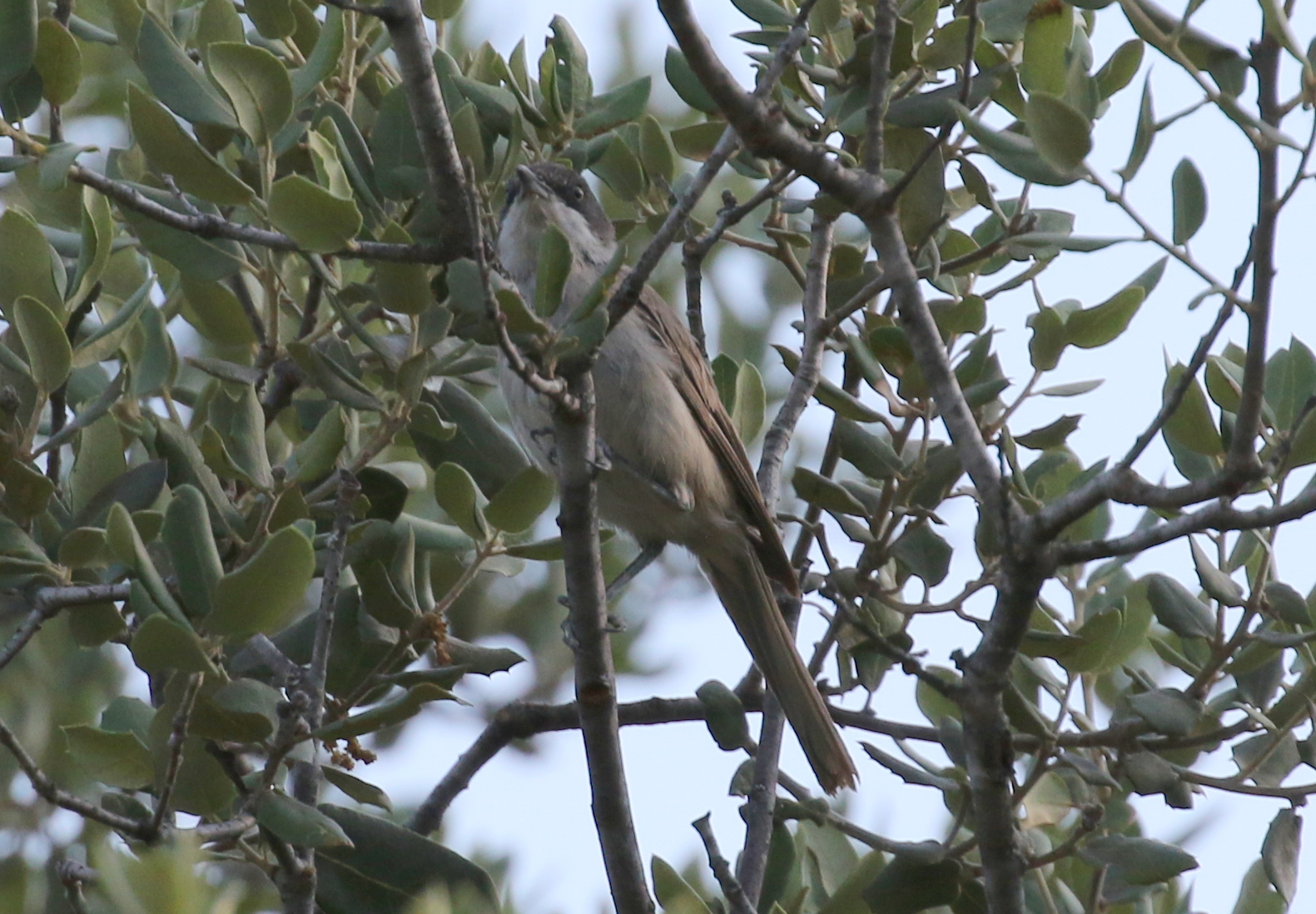 Western Orphean Warbler – a nice bonus to see a family party in Monfrague
Western Orphean Warbler – a nice bonus to see a family party in Monfrague
Up in the sierras, there were more warblers to see. A particularly productive trip produced Spectacled Warbler and Common Whitethroat breeding within a few metres of each other, together with several singing Western Bonelli’s Warblers and a smart male Western Subalpine Warbler. Iberian Pied Flycatcher was a nice bonus here too, an interesting subspecies of the regular Pied Flycatcher which is only found in central Spain.
 Western Subalpine Warbler – up in the sierras
Western Subalpine Warbler – up in the sierras
There were some nice butterflies up the sierras too. The smartest was Two-tailed Pasha and I had at least two of these around the Castillo at Monfrague, resting on the rocks or chasing each other round. There were also several different butterflies around the hotel, including a nice selection of blues around the lawn.
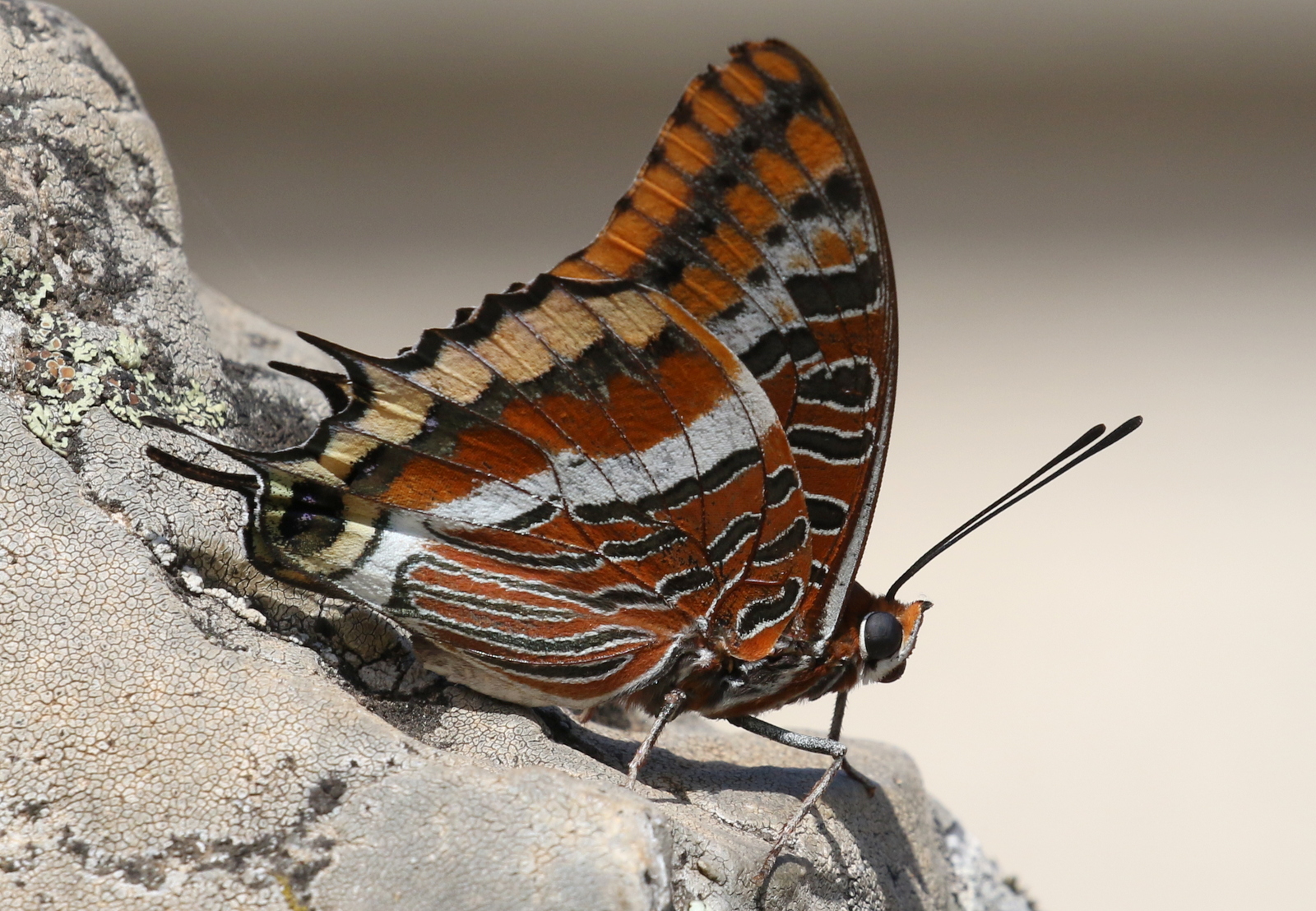 Two-tailed Pasha – by the Castillo in Monfrague
Two-tailed Pasha – by the Castillo in Monfrague
When the temperature got too hot, in the middle of the day, I sometimes retired to the shade in the garden of the hotel, by the swimming pool. Red-rumped Swallows nest in the garden and they would come down to drink in the pool, swooping low across the water’s surface and drinking on the wing. Unfortunately, getting photos of them coming down to drink proved difficult, but they did give great views around the garden and overhead.
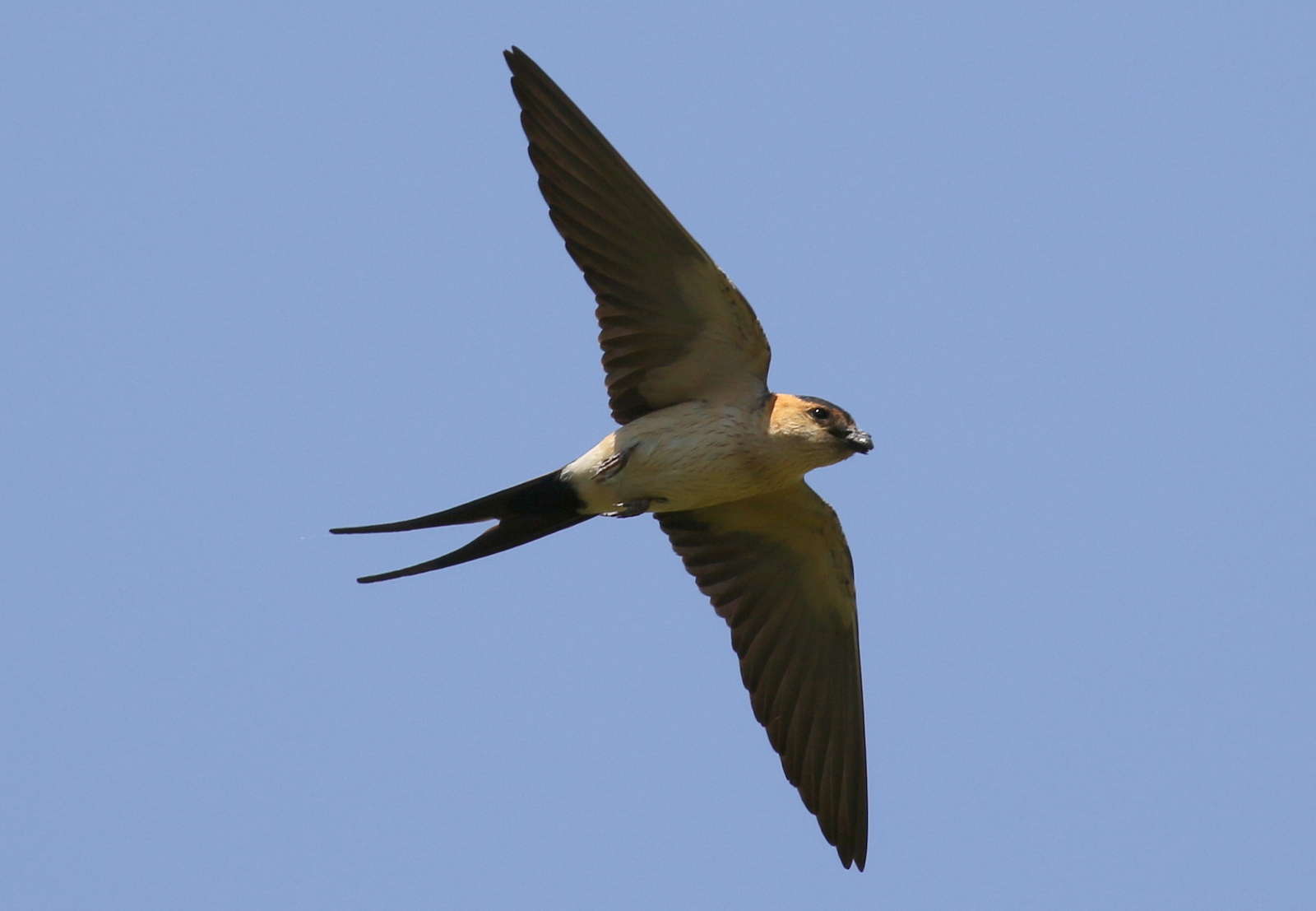 Red-rumped Swallow – nesting in the garden of the hotel
Red-rumped Swallow – nesting in the garden of the hotel
The Red-rumped Swallow nest was on one of the hotel buildings, much bigger than a House Martin or Barn Swallow nest, a very impressive feat of construction!
 Red-rumped Swallow – a very impressive nest
Red-rumped Swallow – a very impressive nest
A family of Hawfinches were up in the trees in the garden too, and the female regularly came down to feed on the lawn.
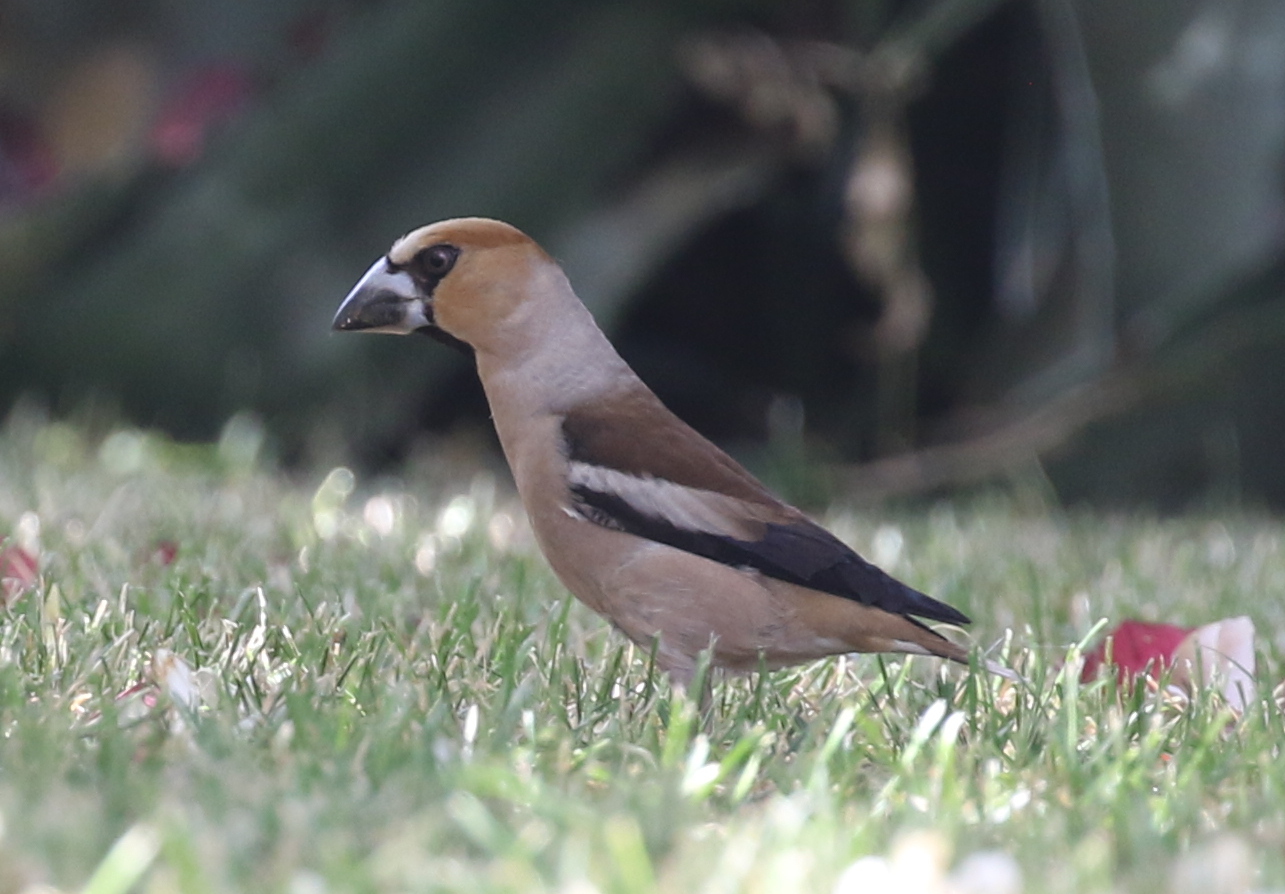 Hawfinch – collecting food on the lawn
Hawfinch – collecting food on the lawn
While sitting by the pool, the Long-tailed Tits would also come down to drink at any puddles left by the watering of the plants. The Long-tailed Tits here are a distinct subspecies, irbii, with a more heavily streaked and darker face than the birds elsewhere in Europe. Interesting to see. There were Short-toed Treecreepers too, and a Nightingale around the garden. A great place to while away the hottest hours of the day.
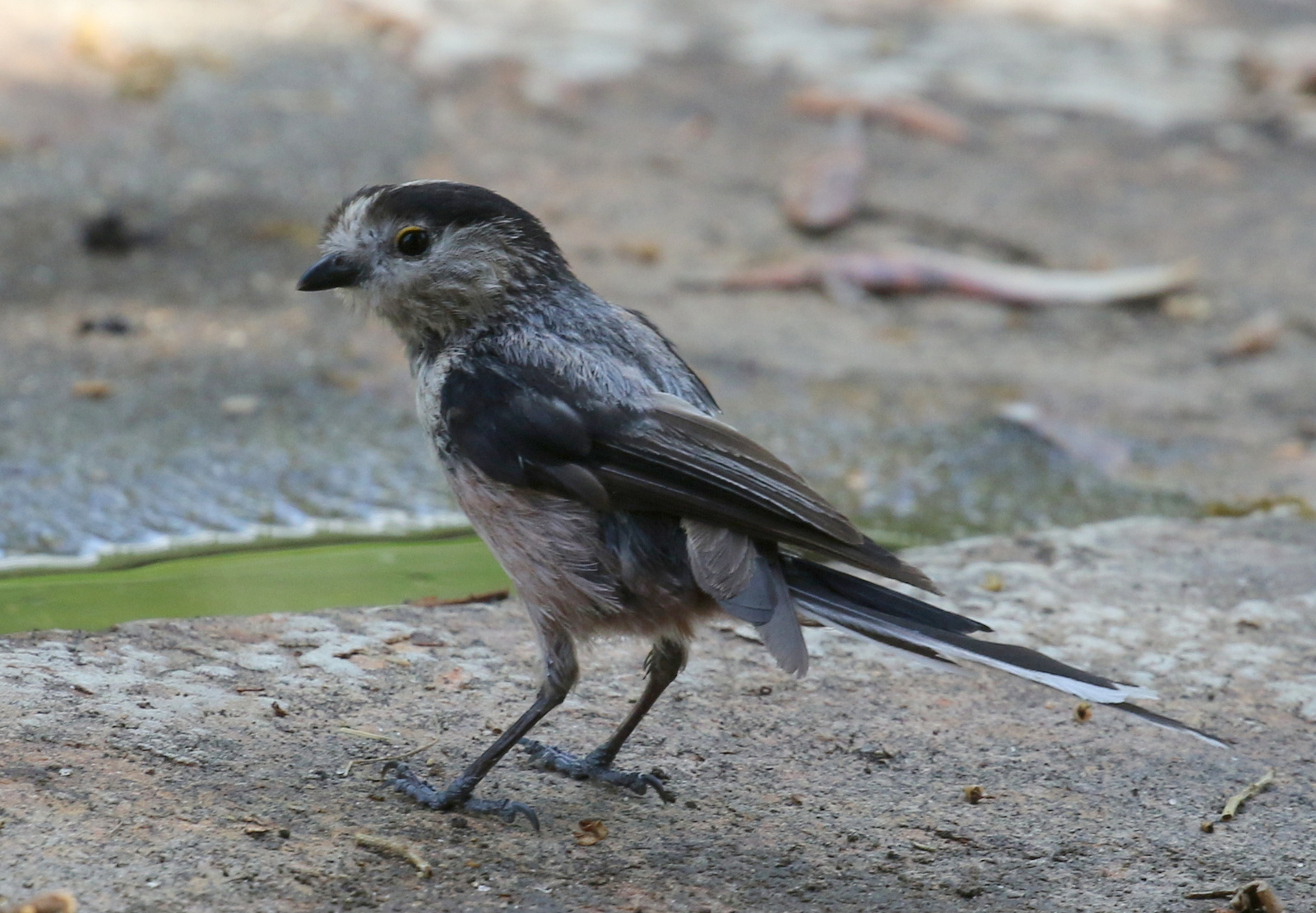 Long-tailed Tit – of the Iberian race irbii
Long-tailed Tit – of the Iberian race irbii
Given the time of year and the heat, I really hadn’t expected to see so much in Extremadura on this trip and it was mainly intended as an opportunity to visit some different sites. As you can see, I enjoyed some great views of some excellent species despite the conditions. Extremadura is well worth a visit!
The trip in January will be similar but different. For a start, it shouldn’t be so hot! Many of the species will be the same – hopefully, it should be easier to find some of the classic steppe species and many of the most sought after raptors – although the summer visitors which I saw will obviously not be around then. However, there are also other birds to look for in January which are just winter visitors, and which I didn’t see this time – Cranes by the thousand which come here from northern Europe, huge rafts of wildfowl on the reservoirs, and passerines like Bluethroat and Alpine Accentor to look for too.
It promises to be an exciting tour to Extremadura in January 2018, so if this blog has whetted your appetite for birding there, then please get in touch. I am looking forward to going back already!
















